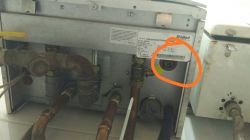This topic has been discussed on the electrode several times.
What is leaking is from the safety valve. In CO it is 3 bars.
When you add water to the central heating, the water heats up, increases its volume and the pressure increases. Yours is above the permissible 3 bars. The most common cause is a problem with the expansion vessel, which should take over the increase in water volume after heating and stabilize the pressure. Either the vessel is damaged or air has escaped from the gas cushion.
It is best to check this by pressing the valve in the expansion vessel. The vessel is accessible after removing the front cover from the boiler. If water comes out of it, it means that the vessel is damaged. If the air flows weakly, it means that the air bag is too small. But in order to "create" the appropriate pressure in the vessel, you need to close the shut-off valves under the boiler - these are the valves under the boiler on the left and right side of the boiler, closed with a flat screwdriver or a 4 mm Allen key, then drain the excess water and pressure from the boiler using the drain valve (one of the side valves (square shut-off valves with an 8 mm open-end wrench) and with the open drain valve, increase the pressure in the vessel to approx. 0.9-1.0 bar and wait a while and check whether the pressure is maintained. If it persists, turn off the drain valve, open the central heating shut-off valves and let water into the central heating up to a pressure of 1.2-1.5 bar.
Important note - turn off the gas in advance so that the boiler does not start the burner in an unvented boiler. Either you need to run the P.00 program to vent the boiler several times or let it try to turn it on with the gas turned off - however, after several unsuccessful ignition attempts, the boiler will throw error F.28 or F.29 - you need to delete this error and let the boiler try to start again. The idea is to vent the boiler sufficiently until you can no longer hear the water and air flowing through the boiler, only the quiet flow of the water itself through the boiler.




